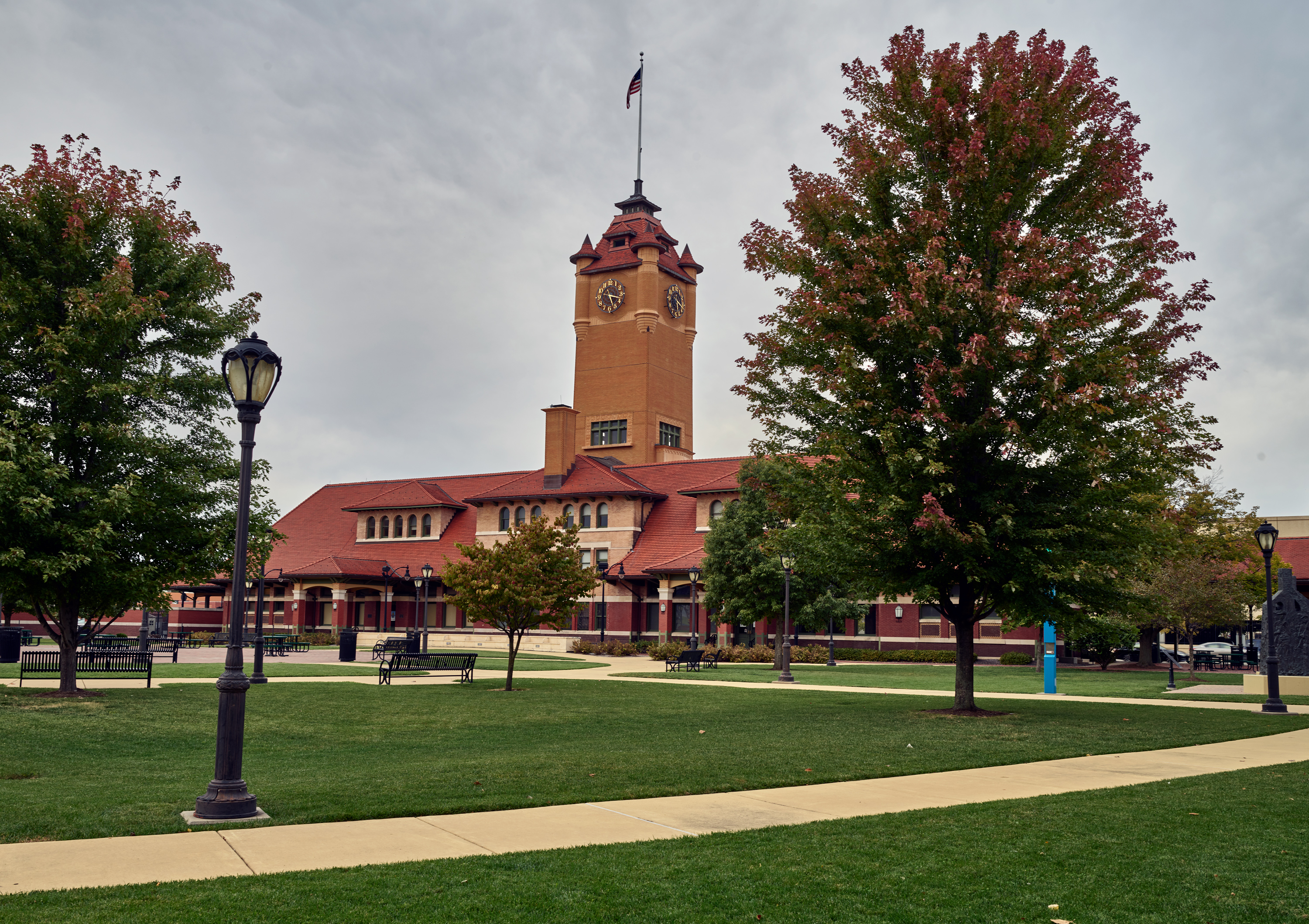Springfield Union Station (Illinois): An 1898 Masterpiece
Published: February 4, 2025
By: Adam Burns
Springfield Union Station, located in Illinois' capital, stands not merely as a relic from a bygone era but as a vibrant testament to the city's rich transportation history.
Commissioned in the late 19th century, this edifice has witnessed the ebbs and flows of railroading in America, while changing its role and significance over the decades.
Located at 500 East Madison Street in the heart of downtown Springfield, and in close proximity to the Lincoln Presidential Library, Union Station boasts a storied past.
Established in 1898, it provided rail services until 1971, when Amtrak redirected its operations to the former Chicago & Alton depot situated three blocks to the west.
Post-1971, the station transitioned to a hub for Illinois state government functions and hosted various private enterprises. In 1978, it earned designation as a site of historical significance on the National Register of Historic Places.
Subsequently, it underwent renovations and was reopened to the public in 2007 as an integral component of the Abraham Lincoln Presidential Library and Museum complex.
Historical Context and Origins
Springfield Union Station was constructed during a time when railroads were the lifeblood of American transportation, facilitating commerce, expansion, and social mobility.
The site chosen for Union Station was strategically located near downtown Springfield, providing proximity to both government buildings and commercial enterprises—a testament to its founders' foresight in city planning and development.
The complex was conceived in the Richardson Romanesque architectural style and intended as a centralized terminal for various railroad companies operating in Springfield, including the Baltimore & Ohio; Chicago, Peoria & St. Louis (Chicago & Illinois Midland); Illinois Central; and the St. Louis, Peoria & Northern (Chicago & North Western).
Although intended for joint use, the IC emerged as the primary operator, with the design attributed to its chief architect, Francis T. Bacon.
Construction commenced in 1897 and was completed in 1898. The station opened for service on January 2, 1898, at the cost of $75,000. Over its 73-year operational span, the complex facilitated significant passenger rail traffic to locales such as Chicago, St. Louis, and beyond.
In 1899, IC acquired the Springfield-St. Louis segment of the former St. Louis, Peoria & Northern. As a result, IC introduced two premier trains, the Daylight Special and the Diamond Special, on June 17, 1900, to rival the existing St. Louis–Springfield–Chicago Chicago & Alton route. By 1936, the streamlined Green Diamond and the Night Diamond replaced these services on the Springfield route.
In contrast, the B&O's service was secondary, spanning routes from Indianapolis and Decatur to Springfield, and another line between Flora, Pana, Springfield, and Beardstown.
Despite being an original tenant of the Union Station, following its acquisition of the Alton Railroad in 1931, the B&O relocated its trains to the C&A station. After the Alton's sale to the Gulf, Mobile & Ohio in 1947, the B&O briefly resumed service at Union Station until finally discontinuing all service on March 24, 1951.
The Chicago, Peoria & St. Louis offered routes from Springfield to Peoria, and Springfield to St. Louis via Waverly and Alton. Evolving into the Chicago & Illinois Midland - which predominately handled coal - the railroad established a new depot near the northern perimeter of its Springfield yard, approximately two miles north of Union Station, in 1937.
Of the five notable rail terminals serving Illinois' capital, Union Station was distinguished by its ornate architecture, unlike the more utilitarian designs of the GM&O, Wabash, and Illinois Terminal facilities.
Passenger service ceased on April 30, 1971, with the discontinuation of the Governor's Special, the last Illinois Central train running between Springfield and Chicago, following the inception of Amtrak.
In its last years, this train was a truncated version of the Green Diamond, which throughout much of the 1960s, was the only train operating from the station. Amtrak continues to serve Springfield through the former G&MO station, situated approximately three blocks west of Union Station.
Architectural Significance
Architecturally, Springfield Union Station is a fusion of formality and functionalism, as exemplified by its design elements and intelligent use of space.
The station’s utilitarian undercurrents are masked by embellishments typical of the Renaissance Revival style, mixing aesthetic appeal with operational proficiency.
Illinois Central's influence remains evident in the station's architecture, with details such as the wooden stair railing sporting trims patterned after the IC logo from 1898.
A striking element of the terminal was its three-story, 110-foot clock tower, a defining feature of Springfield's skyline. In an effort to reduce maintenance costs in 1936, the clock faces' hands were removed, and the tower was dismantled to its base during the summer of 1946.
Inside the station, careful attention was paid to materials and layout. The grand waiting hall featured marble floors, oak benches, ornate lighting, and expansive windows that allowed natural light to illuminate its grandeur.
The ceiling, detailed with beams and mural decoration, offered a sense of openness—a crucial comfort for travelers often fatigued by long journeys. The station's design also catered to segregation norms of its time, with separate waiting areas, ensuring a clear socio-cultural demarcation reflective of societal attitudes.
Decline and Restoration Efforts
With the advent of automobiles and the decline of rail travel post-World War II, Union Station witnessed a dwindling in use. By the mid-20th century, the building had fallen into disrepair, a shadow of its former self. The need for infrastructural adaptation grew pressing, as changing transportation modalities called for reimagining space and functionality.
Restoration initiatives began earnestly in the early 2000s, led by public-private partnerships aiming to revitalize this architectural landmark.
These efforts were fueled by an increasing appreciation for historical preservation and its potential to contribute to urban regeneration.
By 2007, the refurbished station emerged as a prominent museum and visitor center, integral to the Abraham Lincoln Presidential Library and Museum campus.
Contemporary Role and Significance
Today, Union Station serves as both a museum and a venue for community events, effectively repositioning itself within Springfield's socio-cultural milieu. It stands as an interpretive center dedicated to showcasing diverse exhibits related to Abraham Lincoln and local history.
The station’s transformation into a museum aligns with broader efforts to leverage historical sites for educational and tourism purposes, linking past narratives with present community interests.
Union Station’s current model highlights adaptive reuse in architectural preservation, marrying historical fidelity with modern functionality. The building provides versatile spaces for exhibitions, public gatherings, and educational initiatives, all while sustaining its original architectural integrity.
Moreover, it continues to foster a sense of communal identity and pride, standing as a touchstone for both residents and visitors who seek to understand Springfield's historical evolution.
Today
Springfield Union Station stands out not just as a visual reminder of late-19th to early-20th-century railroad architecture but as an active participant in Springfield's urban narrative.
Its journey from a bustling railway hub to a derelict structure, and ultimately to a rejuvenated cultural institution, mirrors the changing tides of transportation, economics, and historical acknowledgment.
By integrating past and present, Springfield Union Station contributes to ongoing dialogues about cultural heritage, urban planning, and sustainable development practices.
As both a resource and a repository of collective memory, Springfield Union Station continues to inspire, educate, and invite exploration—bridging history's legacy with the limitless potential of what lies ahead.
Recent Articles
-
Arizona Polar Express Train Rides: A Complete Guide
Mar 13, 25 11:55 AM
Arizona is home to one of the finest heritage railroads in the nation, the Grand Canyon Railway. During the holiday season they host official "The Polar Express" trips. -
Oklahoma Polar Express Train Rides: A Complete Guide
Mar 13, 25 11:06 AM
Oklahoma is one of just a handful of states offering official "The Polar Express" events, hosted at the Oklahoma Railway Musuem in Oklahoma City. Learn more about this attraction here! -
Milwaukee Road Steam Roster (All-Time): Post-1900
Mar 13, 25 12:19 AM
The Milwaukee Road is best known for its fleet of streamlined 4-4-2s and 4-6-4s which led the "Hiawathas." However, it also operated many other designs. This information highlights its post-1900 steam…



